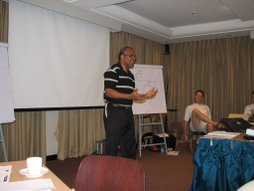My “I AM” list
Many people routinely prepare daily “To Do” Lists to direct their activities and point them to higher levels of efficiency. This practice encourages better time and task management and is not to be discredited.
I am increasingly convinced that there is great value to be gained from maintaining an “I AM” list. The “I AM” list should reflect those things that we want to believe about ourselves. It is a description of “the person that I am” – with modifications.
The modifications come in two basic forms. The first type involves deletion of the negative beliefs that we have about ourselves that limit our capacity for outstanding positive achievement.
The second set of modifications involves visualizing a transformed self that is anchored by positive character traits that we now hold to be true about ourselves.
The principles on which the “I AM” list is based are grounded on a deeper understanding of the role and impact of our self-image.
I quote from Maxwell Malt’s “The New Pscho-Cybernetics” because of the clarity of his presentation.
“By understanding your self-image and by learning to modify and manage it to suit your purposes, you gain incredible confidence and power.
Whether we realize it or not, each of us carries within us a mental blueprint or picture of ourselves. It may be vague and ill-defined to our conscious gaze. In fact, it may not be consciously recognizable at all. But it is there, complete down to the last detail. This self-image is our own conception of the “sort of person I am.” It has been built up from our own beliefs about ourselves. Most of these beliefs about ourselves have unconsciously been formed from our past experiences, our successes and failures, our humiliations, our triumphs, and the way other people have reacted to us, especially in early childhood. From all these we mentally construct a self (or picture of a self.). Once an idea or belief about ourselves goes into this picture it becomes “truth”, as far as we personally are concerned. We do not question its validity, but proceed to act upon it just as if it were true.
The self-image then controls what you can and cannot accomplish, what is difficult or easy for you, even how others respond to you just as certainly and scientifically as a thermostat controls the temperature in your home.
Specifically, all your actions, feelings, behaviour, even your abilities, are always consistent with this self-image. Note the word: always. In short, you will “act like” the sort of person you conceive yourself to be. More importantly, you literally cannot act otherwise, in spite of all your conscious efforts or willpower. (This is why trying to achieve something difficult with teeth gritted is a losing battle. Willpower is not the answer. Self-image management is.)
….. The person who perceives himself to be a “failure type person” will find some way to fail, in spite of all his good intentions or his willpower, even if opportunity is literally dumped in his lap.
…. The self-image is a “premise”, a base, or a foundation upon which your entire personality, your behaviour, and even your circumstances are built.
…. Obviously, it’s not enough to say “it’s all in your head”. In fact, that’s insulting. It is more productive to explain that “it” is based on certain ingrained, possibly hidden patterns of thought that, if altered, will free you to tap more of your potential and experience vastly different results. This brings me to the most important truth about the self-image: It can be changed.
…. “Positive thinking” cannot be used effectively as a patch to the same old self-image. In fact, it is literally impossible to really think positively about a particular situation, as long as you hold a negative concept of self. Numerous experiments have shown that, once the concept of self is changed, other things consistent with the new concept of self are accomplished easily and without strain.”
Your “I AM” list then will be a key determinant of how life unfolds for you. Its purpose is to help you to modify your self-image such that:
* You find your self acceptable.
* You can trust your self and believe in it
* You have wholesome self-esteem.
* You believe that you have creative freedom.
* You have an honest understanding of your strengths and areas that are not yet developed to your satisfaction.
* You break the pattern of negative concepts about yourself that limit your ability to achieve.
* You incorporate positive beliefs about yourself that allow you to consistently achieve positive results.
By now you will realize that a firmly ingrained “I AM” will automatically dictate and direct your “TO DOs”. “What we do” flows directly from “Who we are.” There is a certain inevitability with which the two factors seek alignment with each other. We either bring our actions in line with our self-image or our persistent actions will cause us to modify our self-image to match our behaviour.
Maltz: "When you see a thing clearly in your mind, your creative "success mechanism" within you takes over and does the job much better than you could do it by conscious effort or willpower". This is in support of the practice of "mental picturing" or "visualization" or "imagination practice" or "The Theater of Your Mind" or "Act as if".
Maltz explains: "This exercise builds new "memories" or stored data into your midbrain and central nervous system. It builds a new image of self. After practicing it for a time, you will be surprised to find yourself "acting differently", more or less automatically and spontaneously, without trying."
He recommends, for example, setting aside 30 minutes per day during which you imagine in vivid detail watching yourself on a large motion picture screen. If the imagination is vivid and detailed enough, your imagination practice is equivalent to an actual experience, insofar as your nervous system is concerned.
So, during the 30 minutes you see yourself acting and reacting appropriately, successfully, ideally. See yourself acting, feeling, being as you want to be. Do not say to yourself, "I am going to act this way tomorrow." Just say to yourself, "I am going to imagine myself acting this way now - for 30 minutes today."
Visualization is not a substitute for prayer. Neither is it anti-religion or unscriptural. It can be seen as an active manifestation of asking believing. You watch the things that you pray for unfold before your very eyes. The scriptures support that approach. "And whatever things you ask in prayer, believing, you will receive." Matt 21:22
Be a proactive and consistent “I AM” list user for the entire month of January and see the difference in your life!
Use the list as the platform for your movie script. The movie that you will work on developing and playing over and over in the "Theater of Your Mind" in a relaxed state all through the month of January. Thereafter, your automatic success mechanism can be initiated at will.
Maltz: It comes into operation as you act and as you place a demand on it by your actions. You must not wait to act until you have proof. You must act as if it is there, and it will come through. "Do the thing and you will have the power," said Emerson.
Currently Serving
Today's special
Monday, 31 December 2007
Subscribe to:
Post Comments (Atom)






No comments:
Post a Comment